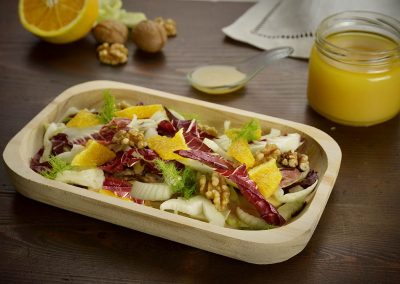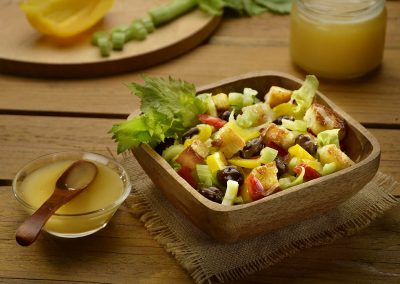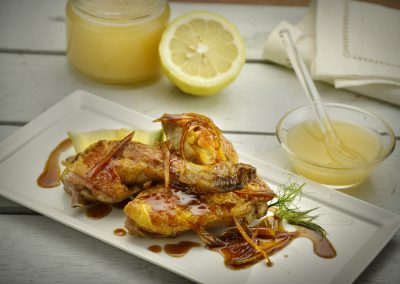Orange Honey

Serves 4:
- 500g of low-fat Greek yoghurt
- 8 tablespoons of orange honey
- Orange juice and rind as required
- A handful of walnuts
- A handful of almonds
- 2 dried figs
- 2 dried apricots
- 2 teaspoons of pollen
Method
Mix the orange honey and filtered orange juice into an emulsion, so that the honey is runnier and softer. Flavour with the orange rind. Chop up the figs and dried apricots, shell the walnuts and break them up roughly using your fingers.
Now assemble the individual pots: in a glass or sundae dish, alternate the ingredients in layers. Place two tablespoons of Greek yoghurt in the bottom, top with a generous tablespoon of honey and orange sauce, then nuts (walnuts and flaked almonds) and dried fruit (figs and apricots), followed by another two tablespoons of Greek yoghurt, before garnishing with a sprinkling of pollen and the flaked almonds. The walnuts and flaked almonds can be replaced with hazelnuts, pecans or macadamia nuts. If you like, you can replace the dried fruit with other varieties (papaya or red fruits) or even with fresh fruit. For extra crunch, in addition to the dried fruit and nuts and pollen, you can use puffed or wholegrain cereals.

Serves 4:
- 2 heads of red Treviso radicchio
- A handful of shelled walnuts
- 1 teaspoon of orange honey
- 2 fennel bulbs
- 2 tablespoons of balsamic vinegar of Modena
- 3 oranges
- 3 tablespoons of extra virgin olive oil
- Salt and pepper
Method
Wash the radicchio and the fennel, cutting them respectively into strips and rounds or small chunks, then pat them dry. Supreme the oranges and cut into slices or chop them, as preferred. Prepare the dressing by mixing together the honey, oil and balsamic vinegar into an emulsion. Season with salt and pepper. Dress the fruit and vegetables with the resulting vinaigrette. Arrange the fennel rounds, radicchio, oranges and chopped walnuts on a plate. Season with salt and pepper. Orange honey is ideal for vinaigrettes.

Serves 4:
- 2 red peppers
- 2 heads of celery
- Half a head of Iceberg lettuce
- 12 pitted green olives
- 1 clove of garlic
- Extra virgin olive oil as required
- 8 slices of homemade bread
For the sauce:
- 2-4 tablespoons of juice of the cooked peppers
- 4 tablespoons of extra virgin olive oil
- 4 tablespoons of white wine vinegar
- 2 teaspoons of Dijon mustard
- 1 teaspoon of orange honey
- Warm water, salt and pepper to taste
Method
Using a vegetable peeler, peel the celery into long strips and place them in icy cold water to crisp them up. Cut the washed, dried lettuce into strips of a similar size. Roast the two peppers in the oven until tender, peel them and cut into 5cm wide strips. Place the peppers in a bowl, season lightly with salt and leave to rest for 30 minutes. Start making the sauce, using a sieve to collect all the juices from the peppers. Place the juices in a food mixer and add the same amount of oil and white wine vinegar; add two teaspoons of mustard and a teaspoon of orange honey, blending all the ingredients well and adding a little warm water if necessary. Then season with salt and pepper. Mix the lettuce and celery strips in a salad bowl, then dress with some of the sauce and toss well to coat the salad. Brush the slices of bread with a little oil and toast them in the oven; rub the clove of garlic on the toast to accompany the salad. Plate up the salad and add the peppers, green olives and celery leaves, then drizzle the remaining sauce on top. Serve the salad with the garlic bruschetta.

Serves 4:
- 1 guinea fowl
- 4 cloves of garlic
- 4 tablespoons of orange honey
- 6 tablespoons of extra virgin olive oil
- a pinch of oregano and thyme
- 2 lemons
- salt and pepper to taste
Method
Cut the guinea fowl into pieces, season with salt, pepper, a pinch of oregano and another of thyme, the finely chopped garlic and a drizzle of extra virgin olive oil.
Leave to rest for a few hours. Squeeze the lemons and add a glass of warm water to the juice, then stir in the honey until it dissolves. Brown the guinea fowl in the remaining extra virgin olive oil in a casserole dish: as soon as it is browned, pour on the lemon juice and continue cooking.
Continue cooking until the guinea fowl has absorbed all the liquid and is a lovely golden colour. Serve immediately.
